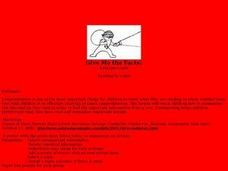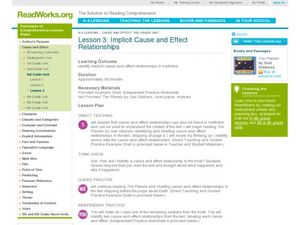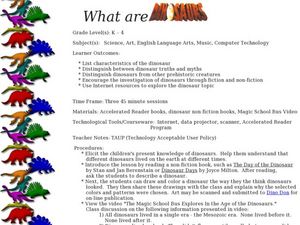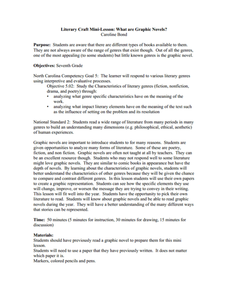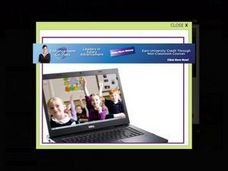Curated OER
Give Me the Facts!
Pupils study how to summarize a reading passage to improve their comprehension. They read a non-fiction passage and use five steps to summarize it while working in groups of three. Next, as class, they decide which group provided the...
Curated OER
Strength in Summarizing
Third graders practice summarizing passages while creating a fishbone map of important details in non-fiction text. They examine how to tell the difference between important and less important details by highlighting them in reading...
Curated OER
Science Summaries are the Bomb!
Fifth graders read a dissection article and complete close reading activities for the text. In this reading skills lesson, 5th graders read an interactive frog dissection article in teams. Student teams complete a KWL chart and...
Curated OER
Autobiography
Sixth graders read and write autobiographical sketches, determine the author's purpose in writing, and type paragraphs using WP utilities.
Curated OER
"Spelldown" by Becky Mushko
Learners read Spelldown, by Becky Mushko and consider how it portrays the Appalachian community. They define and discuss vocabulary presented in the story and write a comparison/contrast paper analyzing two of the story's characters. The...
National Center for Case Study Teaching in Science
A Strange Fish Indeed
Communication is one of the most important aspects of science. In a two-day activity, your high school or college-level biologists will read excerpts from a fictional diary of Marjorie Courtenay-Latimer, the woman who discovered the...
Curated OER
A River Ran Wild: An Environmental History
The Nashua River serves as the focal point of an investigation of the treatment of and care for natural resources. A reading of A River Rand Wild: An Environmental History by Lynne Cherry, launches the study and class members consider...
Curated OER
Reading Multicultural Literature
High schoolers read several fictional pieces which examine issues of urbanization and rural cultures. They discuss how the place a person lives affects the kind of person they become.
Curated OER
Let's Sum It All Up
Fourth graders watch a modeled lesson on summarizing the main ideas of a non-fiction passage. They silently read a passage about sharks before making a class summarization chart. Next, they read a small passage and summarize it...
Curated OER
Keep It Short!
Students examine the process of summarizing text. They participate in a class discussion, and read an assigned passage from their textbook, highlighting the main points of the text. Students then write a short summary of their...
Curated OER
Parts of a Story
Learners read a short fiction book and demostrate comprehension by identifying the main characters, setting, conflict, theme, and summarizing the main points. They organize the information in Inspiration and create a powerpoint to show...
Curated OER
Implicit Cause and Effect Relationships
Cause and effect relationships can be found in both fiction and non-fiction texts. As they read the book, The Planets by Gail Gibbons, learners keep an eye out for cause and effect relationships. They chart all of the causes and effects...
Curated OER
Identify and Analyze Literary Concepts
Young scholars explore plot structure, conflict, setting, and mood. In this literary elements lesson, students read Rosa Parks, My Story and complete the provided plot outline worksheets. Young scholars discuss the text elements of...
Curated OER
From Fact to Fiction: The Origins of Constellations
Sixth graders investigate the constellations. In this constellations lesson, 6th graders discover where the constellations are located and the myth associated with them. Students create their own myth and make a slide show about stars...
Curated OER
What are Dinosaurs?
Young scholars explore the attributes of dinosaurs. In this dinosaur lesson, students read books and watch videos featuring dinosaurs. Young scholars also research dinosaur traits using Internet sources.
Curated OER
Author In The Spotlight
Complete an in-depth study of the works or a specific author. Working in pairs, students read at least four works by the same author. After completing the reading, they create an essay comparing and contrasting the works and create an...
Curated OER
Build Mastery: Cause and Effect
After you've begun identifying the cause and effect relationship within literature, it's time to give scholars some independent practice. Review the concept before handing out this graphic organizer. Learners use the book they are...
Appalachian State University
What Are Graphic Novels?
To do this engaging and pleasurable activity, your learners should have already read a graphic novel, and produced a piece of writing that can be reproduced into the format of a graphic novel. This exercise provides a script that...
Curated OER
Author's Purpose
Sixth graders brainstorm the reasons authors write, and they list their responses on the board. Students discuss each purpose they have listed.Students work independently to read the selection "Tarantulas and Typhoid" by...
Curated OER
Book It to Pizza Hut
Students participate in reading a story and writing a book report on the computer. They engage in computer skills such as, saving and printing their reports. They read their reports to the teacher and class.
Curated OER
Book Buffet
Students are encouraged to develop a love for reading by sampling different types of literature. They are encouraged to read one of the books that is sampled. The sample should be challenging for the reader without causing discouragement.
Curated OER
Comparing Themes Across Texts
Read various texts to compare the themes across each text. Learners write a journal entry describing the most beautiful scenery they've seen and use a map of the United States to locate the Sequoia National Park and Muir Woods. They then...
Curated OER
Imagination Or Observation?
Read the books, "Frog and Toad Are Friends," and "Tale of a Tadpole," to distinguish between fantasy and reality in the books. In this reading comprehension lesson plan, pupils review the similarities and differences in each book with...
Curated OER
Lesson Plan fo The Magic Eyes of Little Crab
Interested in a "how and why" story to read with young students? In this storytelling lesson, readers will discuss sea creatures, focusing on practicing new terminology through retelling the story. This resource provides a list of...
Other popular searches
- Non Fiction Reading Passages
- Reading Non Fiction
- Reading Non Fiction
- Active Reading Non Fiction
- Shared Reading Non Fiction
- Reading Non Fiction Text
- Non Fiction Reading Pre Test
- Non Fiction Reading Skills
- Non Fiction Reading Journal
- Non Fiction Reading Logs
- Lesson Non Fiction Reading
- Non Fiction Reading Lessons
